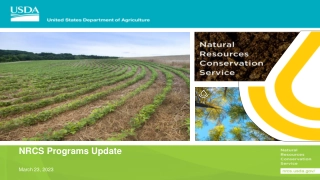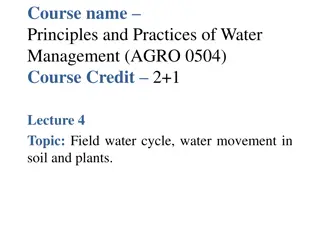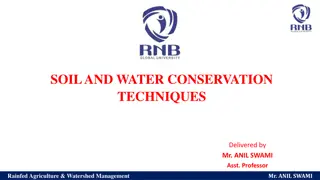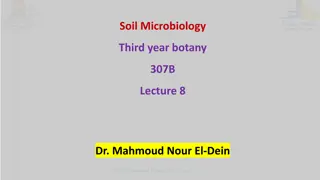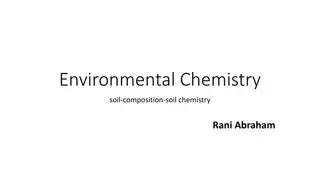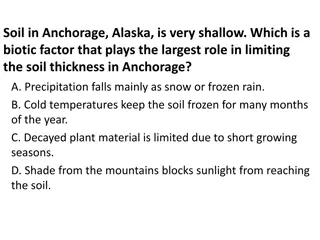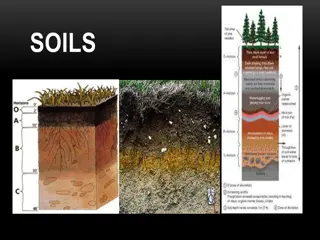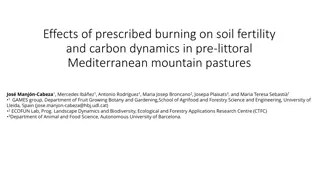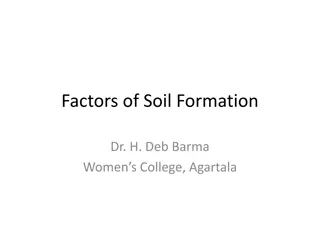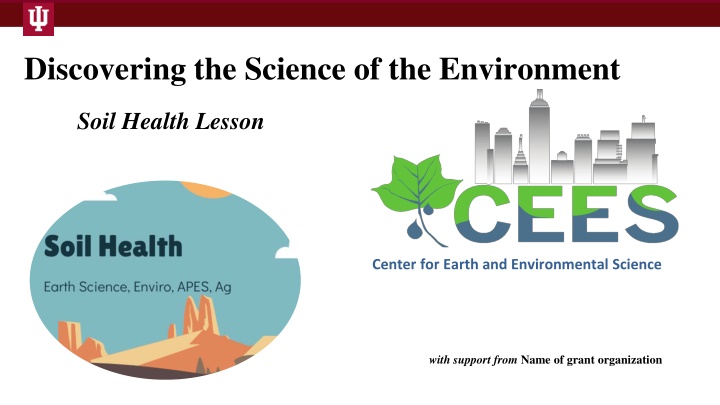
Soil Health for Environmental Science Lessons
Explore the essential components of soil health such as pH, potassium, nitrogen, phosphorus, composition, permeability, and density while learning how they impact plant growth and the environment. Discover the significance of maintaining soil balance for sustainable agriculture and environmental conservation.
Download Presentation

Please find below an Image/Link to download the presentation.
The content on the website is provided AS IS for your information and personal use only. It may not be sold, licensed, or shared on other websites without obtaining consent from the author. If you encounter any issues during the download, it is possible that the publisher has removed the file from their server.
You are allowed to download the files provided on this website for personal or commercial use, subject to the condition that they are used lawfully. All files are the property of their respective owners.
The content on the website is provided AS IS for your information and personal use only. It may not be sold, licensed, or shared on other websites without obtaining consent from the author.
E N D
Presentation Transcript
Discovering the Science of the Environment Soil Health Lesson Center for Earth and Environmental Science with support from Name of grant organization
Developed by CEES Soil Health Earth Science, Enviro, APES, Ag
Bellringer Take a look at the food brought in. Which of these would we not be able to have anymore if the soil in the midwest was ruined? What do plants need in order to grow? Think back to your biology and the matter cycles lesson from a couple of days ago. Is there anything wrong with our soil now? What things have humans been doing that affects the soil?
Components of Soil Health pH Potassium pH shows us how acidic or basic the soil is Potassium acts as a catalyst in chemical reactions for plants Why is this important Potassium helps plant metabolism: photosynthesis, efficient use of water, and the formation of strong roots and stems. Potassium strengthens their natural mechanisms to resist disease and extreme weather. Why is this important? The acidity of soil determines how well the soil holds nutrients. The more acidic the less nutrientes.
Components of Soil Health Nitrogen Phosphorus Is a vital part of a living cell. It makes up DNA, and is a crucial part of amino acids. Is a nutrient found in the soil. It is a product of the rock cycle and as a result there is not much in the soil. Why is it important? Why is it important? Young plants absorb large amounts of phosphorus, which speeds seedling development and promotes early root formation. In mature plants, phosphorus is vital to the development of healthy seeds and fruit. Nitrogen is directly involved in photosynthesis. It stimulates above- ground growth and produces the rich, green color characteristics of healthy plants.
Components of Soil Health Composition Permeability Is a measure of the size and connectedness of the open spaces in a rock or soil. Generally, materials with larger particle sizes are more permeable. What the soil is made of. There are different components of soil. Sand, Clay, and Silt. A combination of sand, silt, and clay is called Loam Why is this important? Why is this important? The composition of the soil determines how well the soil holds water, drains water, hold nutrients and supports soil microorganisms. Soil that is more permeable drains more water. Roots don t get waterlogged and more oxygen is available for the roots and the soil microorganisms.
Components of Soil Health Density Temperature Soils can become compacted (more dense) in many ways, such as from overgrazing by livestock or from a high amount of traffic over the soil. Soil temperature directly affects plant growth. Soil temperature is the factor that drives germination of seeds. Why is this important? Why is this important? Soil temperature impacts the rate of nitrification. It also influences soil moisture content, aeration and availability of plant nutrients. Soils that are too warm or too cold are not healthy soils. Soils that are very dense have high strength and low porosity and do not support plant growth.
Components of Soil Health Microorganisms Soil Depth Is the living part of the soil. Microorganisms can include nematodes, bacteria, and fungi This is how deep the A Horizon goes. Where the plants have roots and the microorganisms dwell. Why is this important? Why is this important? Soil microorganisms play an essential role in decomposing organic matter, cycling nutrients and fertilizing the soil. Soil microbes produce lots of gummy substances that help to make a healthy soil structure. Fungal filaments also stabilise soil structure because these threadlike structures branch out throughout the soil. Soil depth can greatly influence the types of plants that can grow in them. Deeper soils generally can provide more water and nutrients to plants than more shallow soils. How deep is the soil in the Midwest? Soil microorganisms lock carbon into the soil for long periods. Abundant soil organic carbon improves soil fertility and water-retaining capacity.
Development of this project was supported by: Organization Organization logo Organization Organization logo For more information about the Center for Earth and Environmental Science and the Discovering the Science of the Environment program, go to: https://cees.iupui.edu

